- Get link
- X
- Other Apps
How To Grow Food in a Small Garden - Turning a Wasted Space into an Edible Garden - More Than 50 Varieties in 500 Sq Ft
- Get link
- X
- Other Apps
You can grow food in small places, in fact even with a small garden you can pack a punch and grow your own food both fruit and vegetables. With permaculture principles, vertical gardening, pollinator considerations, composting and close planting techniques it is possible to grow an edible garden full of versatility in a small space.
How to Grow a Small Garden:
We have more than 50 varieties of fruits, herbs and vegetables growing in our small southern-facing side yard, a yard that was previously just wasted, unused space. There are many small garden vegetables, but we have found that to get the most success from a small garden, you need to have diversity, growing both annuals and perennials, so that there is never an off season, you need to cater to pollinators, and you need to embrace vertical gardening in a creative way that works for your space.
Container gardening has proved to be a great way for us to grow many different varieties without them taking over, and we pay great attention to the health of the soil though amending with homemade compost, homemade composted chicken manure and vermicompost. Still, being able to put certain plants and trees in the ground will help you maximize your production, and it will also help create a microclimate.
When we moved to our current home six years ago, we were thrilled to have our own garden area, since we'd been sharing a miniscule garden (with a huge mango tree) for the past decade before moving here.
Our garden is small and diverse. We only have sun on the eastern and the southern sides of our home, since we're surrounded by a beautiful park-like property to the west and north, so we have huge trees towering over us. We let the leaves drop and squeeze away weeds, and outside of gardening areas we collect the leaves for compost and pot fillers.
The Beginning of Our Small Garden:
Our garden has come a long way, and what was once wasted space with the sun burning up anything we tried to grow, now provides lots of fruits and veggies for our family. On the southern narrow side, I looked at the blank slate and saw a future lush tropical garden with lots of fruit plants and trees. With only 500 square feet at the side of the house, the last six years have been a lot of trial and error, as we figured out what worked and what didn't work in the space. It took a lot of hard work, and the first thing we did was to install a fence for privacy, as we have a neighbor close by on the southern side of our home.
August 2016
February 2017
March 2017
We started off our garden with two small square foot gardening beds, but it was difficult to grow anything, because the side of the house was burning up in the middle of the day.
In the beginning we had the chickens roam free, but we lost many seedlings and almost lost our first banana tree to them as well, so they now have a small screened-in area in the back and only come into the garden area, when someone is out there working. We were without neighbors on the south side for a few years, but before that home was sold, we moved our fence out to the property line, which added about a foot more to the side yard.
Our Small Garden Transformation:
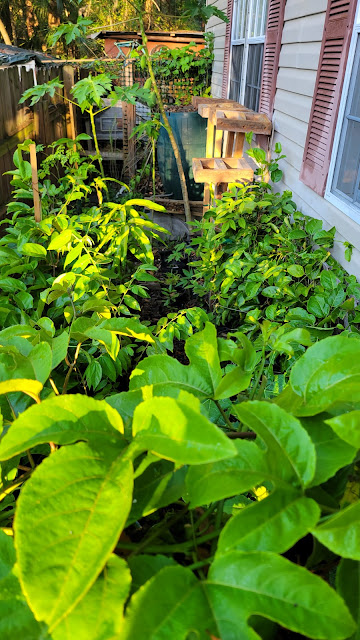 |
| East of the steps |
October 2022
 |
| West of the steps |
We plant the plants in most need of water close to the staircase, as it is easy to throw out any water saved in the kitchen. At the side of the steps we plant tomatoes, so our youngest son can pick them in the morning.
On the eastern side of the staircase, we have one of our nurseries, where we grow new plants in small pots beneath the canopy of the established plants and trees.
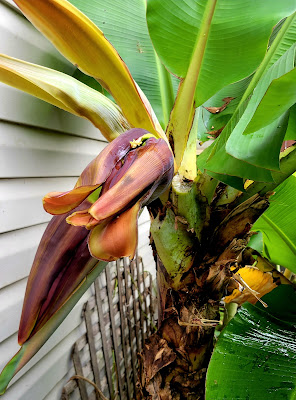 |
| Double bloom on a dwarf Musa Cavendish Banana |
We have sacrificed walking space for food production, and as a result the path is narrow, but it is so worth it to get more food and more plants squeezed into the space. Since we have a neighbor close by on this side of the house, it is not a space that we use for anything but food production, and the garden also helps provide privacy for us, as we are looking out at greenery instead of another house.
We have many papaya trees in the ground and some in pots, all grown from seeds and produce fruit within two years of planting. A passion fruit vine grows on a rescued trellis piece beneath an ice cream banana, and a cattle panel provides growing space for two grape vines over the garden, which also gives shade cover to the strawberry plants during the hot summer months.
There are two vertical strawberry planters, and a ground cover of sweet potatoes and cuban oregano keeps the weeds away and provides greens for our family and the chickens almost year round.
In the shade of the grape trellis we have two starfruit trees in pots, then two Cavendish bananas in the ground followed by more papayas. The Cavendish banana was one of first plants here, and we've gotten several clusters of bananas from it. Right now we've got two Cavendish pups ready to take the place, once these plants give us bananas and need to be cut down.
Some of the potted plants are pomegranates, peppers, tomatoes, American persimmons, passion fruit, aloe, citrus and herbs.
At the end of the space, we have two rain barrels to help conserve water, and with the longer stretches between rain here in Northeast Florida, the rain barrels have proven to help significantly. Certain plants also prefer rainwater to city water, and our bananas and papayas especially perk up by the use of rainwater versus city water.
The bananas and papayas also provide some shade for our southern windows, which helps lower the temperature inside and saves us money on the electricity bill.
 |
| Passion vines surround the Chaya, salad trees and fruit trees. |
On the western side of the steps, we have two passion vines growing surrounding our growing space, one is on what used to be the chicken fencing in the middle and then up around the stair railing. This is where it meets the second passion fruit vine, which grows on an old trellis up against the house that someone had dumped in nearby wetlands.
The passionfruit vines in full sun grow profusely, and we cut frequently to prevent them from taking over or growing up the side of the house. This is a good problem to have, as the leaves are edible and great for chicken food.
 |
| Passionfruit vine in bloom |
One of the passion fruit vines is currently blooming, and it is self pollinating, as the fruits show up soon after the flower. We grew these vines from a purple passion fruit from the grocery store.
 |
| A passion fruit grown from a grocery store passion fruit seedling. |
We used to grow tomatoes and annual vegetables in the garden beds next to the steps. In the past few years our focus has been on creating permaculture with perennials in our small garden, which is less time consuming, demands less water because of the deeper roots, and eventually will be more productive. We still grow annuals in pots and in between the perennials, but they are no longer our focus.
We purchase our fruit trees small (usually at less than 1 ft) or grow them from seeds or cuttings, because patience is a friend of the frugal gardener. We then grow them in pots, until our food forest area is ready for planting in the ground at The Land, or we prune them to stay small by the house.
We have two unknown mango trees grown from seedlings and two Haden mango seedlings, which we are pruning to keep small thanks to the lessons learned from the book Grow a Little Fruit Tree. Our oldest mango tree is five years old, but it is only around 4 ft tall. (See the right side of the image below)
Closest to the steps are 3 salad trees. Two Auntie Lillies South Sea Salad Trees and Chief Kubo's Prize South Sea Salad Tree, which are great alternatives to lettuce growing here in Florida.
Our Jamaican Cherry aka Strawberry tree (Muntingia Calabura) is taking off, and it's loving the sunny side of the house. Below it we have a black sapote, a white sapote, jaboticaba, cherry of the Rio Grande and a blackberry jam tree all growing bigger in pots with some protective shade from the Jamaican Cherry tree. These will eventually be moved to the fruit forest, but for now the small fruit trees enjoy the protection of our house and the other plants.
A chaya (tree spinach) separates the salad trees from the isolated Everglades tomato area next to some chili pepper plants.
Then a pigeon pea, katuk and another Chaya separate the Everglades tomatoes from the chives and garlic chives, before we get to the newly-created dragonfruit area that gets the least amount of water. We have created five trellises out of cedar wood for five different dragonfruits (pink/white, red, purple and yellow dragonfruit), and in front of them two small olive trees (Coratina olive and arbequina olive) are growing in pots.
We put the dragonfruit trellises in an area that we did not need to walk by, as they will grow over the trellises and cascade down in front of these. We've kept the trellis at around 5 ft, because it meant we could cut a 10 ft piece of cedar wood into two saving money, and because it keeps the plants below the fence, on the few days when we do get near freezing every year. We also placed them next to a rain barrel, which will help keep the area warmer as well when full.
Behind the dragonfruits we have cucumbers growing up a trellis, and in between the fruit trees we have peppers, malabar salad, Okinawa spinach, sissoo spinach, longevity spinach, Hoan Ngoc and much more.
We've got papaya trees everywhere in all sizes and stages to ensure a never-ending production. We lost a few papayas to the freezing temperatures earlier in the year, and we cut many back, so they are just now beginning to produce again.
 |
| Moringa, passionfruit and papaya side by side. |
On the middle trellis (See photo above), which was once a fence separating the garden from the chicken run, we've got the passionfruit vine climbing, and on the outside we have moringa and Mexican sunflowers in the ground and then pots with mints, tomatoes and peppers lining the narrow pathway.
We used this green plastic fencing for our chicken coop and vertical growing spaces, and more than 3 years later, it is still looking great with no fading.
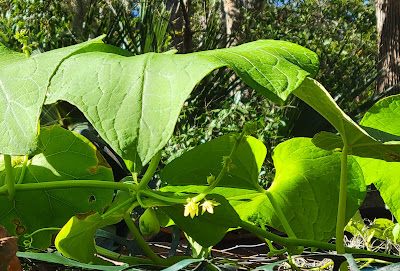 |
| Chayote squash growing over the chicken coop |
A rain barrel separates the garden area from a sweet potato bed, and the sweet potatoes, muscadine grapevines and a dragonfruit climb up the fenced-in chicken run and meet two chayote vines in the middle, which are growing from the other side of the chicken run.
In addition to providing food for our family of seven, the garden also provides food for our chickens and green fertilizers for our banana trees through chop and drop.
We always try to add pollinator plants for better food protection, so we have lots of milkweed, nasturtium, firebush, marigolds and yarrow planted and growing depending on the season. Despite the fence around the garden, we have had plenty of wildlife visitors including a tiny white rabbit, a tortoise, snakes, countless squirrels as well as armadillos, and we have a wild garden cat that loves this protected side of the garden.
An Edible Garden on a Budget
Growing a small garden can be rewarding for the entire family, and our small, edible garden provides much more than just food, as the privacy and shade it gives us are priceless.
We are on a teacher's budget, and that is why we grow most of our food from seeds and cuttings, but purchasing plants small and pruning them to stay small while still producing, is not only cost saving, but also space saving.
While having more plants, trees and varieties help with pollination and food production, we have found that we just need to buy one plant, and then we can continue to propagate this plant or tree by cuttings or air layering, thereby getting more for our money. We also find free plants at the side of the street and elsewhere, we do a lot plant swapping with other plant lovers, and we give away lots of plants to neighbors hoping to create a pollinator paradise in our community.
While we are in St. Augustine, Florida, zone 9a, the concepts of growing food in a small garden can be utilized anywhere. Just find perennials that work for your growing zone, and combine them with the methods we have talked about such as vertical gardening, growing in pots and closely interplanting your annuals with your perennials. Once you have created a diverse growing space, and provided areas of shade, your garden will flourish and provide lots of food for your needs.
You can read more about growing your own food from seeds and growing fruit trees from cuttings right here at Dancing Treetops. If you have a question, please don't hesitate to reach out via email or on our social networks.
- Get link
- X
- Other Apps
Comments
Popular Posts
Troy-Bilt Wood Chipper - Super Tomahawk = Our No. 1 Tool For Better Composting
We could not have gotten as far with our sustainable land clearing and composting, if it had not been for our power horse, our Troy-Bilt Super Tomahawk wood chipper with its 8 HP Briggs & Stratton motor. We purchased this 31+ year-old wood chipper off Craigslist for $200 about a year and a half ago, and it is still going strong. Troy-Bilt Super Tomahawk Wood Chipper
Zone 9A/9B Gardening Calendar - North East Florida Planting Schedule
Gardening in Florida is a very different experience than gardening in the rest of the country, and growing fruits and vegetables in North East Florida is a very different experience than gardening down south. It has taken us about five years to adjust to the zone 9 planting schedule, and while there are many zone 9 garden guides out there, we felt that there was a need for a simple, user friendly zone 9A/9B planting calendar.
How To Remove Palmetto Palms
If you have ever tried to remove a palmetto palm by cutting it down, you will likely have realized that removing palmettos is tricky. So, when we got ourselves a piece of land with about half an acre of these wonderful palmetto palms, also known as saw palmettos or shrub palmettos, we knew that we had a challenge on our hand.
Where To Find Free Nursery Pots and Planters
Every gardener needs something for their plants to grow in. Whether it is directly into the soil in your garden, into a garden bed, nursery pots, ceramic pots, terracotta pots, or if you get more creative, you need something for your plants to grow in. That's why we're always looking for free nursery pots and cheap planters.
How to Transplant a Banana Tree
Wondering how to transplant a banana tree? I know, it's not a tree, so wondering how to move a banana plant? Bananas are pretty easy to move, and they're pretty hardy too. The best time to transplant a banana plant is in the rain season, but I've planted and re-planted banana plants all year round, just remember to water well if it doesn't rain. Last year I planted a small ice cream banana pup in front of our home, but I was negligent in my research and didn't realize just how big it would get. I prefer moving banana trees in the rain season, but the leaves were getting too close to our power line, so it had to be moved. The roots of banana trees aren't very deep, and they will quickly re-establish, if you give them some love and water. The root ball of a 1 year old Grand Nain banana We've been preparing an area at The Land for banana babies, since we now have six different banana varieties at the house and these are beginning to give us pups. Today was th...
How to Grow Mulberry from Cuttings
Our favorite mulberry bush is in danger of eradication, so for the past year or so we have been growing mulberries from cuttings. Our children love eating fruit straight from the trees and bushes, and while we lose wild areas every day to construction and development in our community, we still have a few areas left untouched for now. Some mulberry trees are simply too tall for great mulberry picking, but this one mulberry bush is low and spread thick like a bush. Mulberries look similar to blackberries, but they are sweeter and juicier. They do not hold up well, which is why you will not find them in the stores, but we freeze any leftover mulberries to use in our weekly smoothies. Wild blackberries and wild mulberries We've taken cuttings three times from the mulberry bush. We waited until after fruiting last spring to take the first cutting, and the second time was about four months after fruiting. The third set of cuttings we took was in late winter, just as the mulberry bush had...
Save Your Papaya Trees After Cold Damage
Papayas are susceptible to high winds and freezes, but do not let that prevent you from growing papayas in zone 9a or 9b. In our experience, papayas are pretty cold hardy, but they do not like temperatures below freezing, especially not a sustained time with freezing temperatures. Temperatures below 40 degrees F/4 degrees C will make the papayas begin to look sad, but it is not until the temperatures hit freezing, that the papaya trees will sustain damage enough to kill the papayas. Last winter we had two quick freezes here in St. Augustine (growing zone 9a), and while our tallest papayas looked sad after the first freezing night, it was not until the second freeze that they were defeated. How to Save Papayas After a Freeze: After a freeze wait and see for a week or two to determine where you need to cut your papayas. If another freeze is imminent before your wait or see period is over, make the cut low, cover and protect. Look for new growth or a firmer trunk. Cut the papaya trun...
How To Make Permanent Plant Tags out of Recycled Plastic, Aluminum & Copper
We have lots of citrus trees in the garden, but until they produce fruits, they will be just that - citrus trees - because I have no clue what type they are, since most of my plant tags never held up. I've tried many different plant tags from chalk signs to plastic and the infamous popsicle stick. All failed the test of time, but when I started selling plants, I had to come up with some way to identify the plants and trees to make it easier for the customers. I wanted something that would last at least 6 months, could stand up against the weather, and I began looking for plastic plant tags. I had a hard time finding affordable, recycled plastic plant tags, so I decided to create my own permanent plant tags . (< see video) We've also begun a complete revamp of our front garden, which means more plants, and we've got lots of plants and trees growing for our future garden at The Land. For these plants, I wanted permanent plant labels that could contain both the common name ...
Finding Free Plants on Craigslist
If you are looking to add new plants to your garden, make sure to keep an eye out for free plants in the free section on Craigslist. We have picked up free plants a few times, when someone is clearing out their garden, and in return we make sure to post items as well. This morning I spotted a post for a free estate sale on Craigslist, and it included potted plants. It was in a fancy neighborhood by the beach, where an old house was being torn down to build a new huge one. We picked up several knick knacks such as plates, vases,paintings, lamps, a coat rack, a book shelf and more, and we also brought home as many big pots and plants as our mini van could fit. Free pots and plants These pots were the big ceramic kind that are not in our teacher's budget, and there were lots of different plants too. The plants need to be re-potted and re-nourished, but we've added some new plant species to our garden, which we will make sure to create more plants from trough seeds and ...
How To Grow Papaya From Seeds
Papaya is one of the easiest fruit trees to grow, if you provide them with the right conditions. Here in North East Florida we are in growing zone 9, and while papaya prefer warmer winters than we have here, we have still had great success. Eat a papaya, grow a papaya. We got the idea to grow papaya from seeds, when one of our children began suffering from constipation. The pediatrician suggested that we added papaya to the diet, because papaya is a diuretic. However, papaya can be expensive often costing $5 for a single fruit, and sometimes papaya can be hard to find at the store. For a frugal family of seven, this means papaya is a luxury, so we now make sure to have papaya trees of all sizes planted around the house. Each papaya fruit has a myriad of seeds, and they are so easy to start. Papaya does not like to be transplanted, although we have been able to do so with varying degrees of success, so plant the papaya directly in the soil outside. If you are in zone 10+, you ...










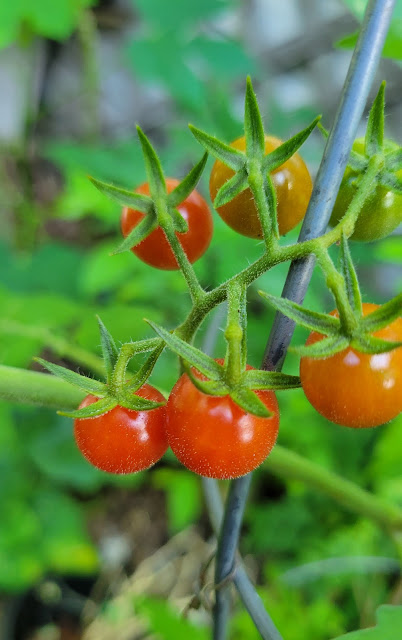
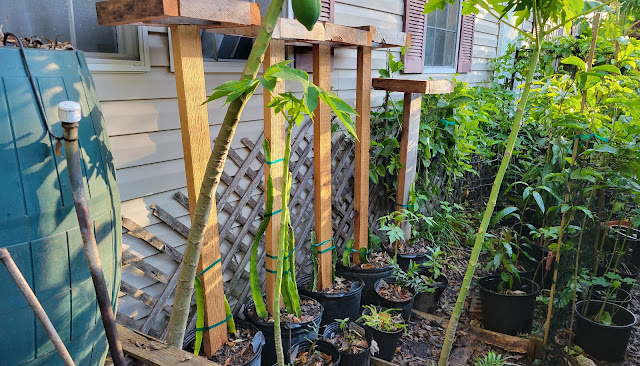


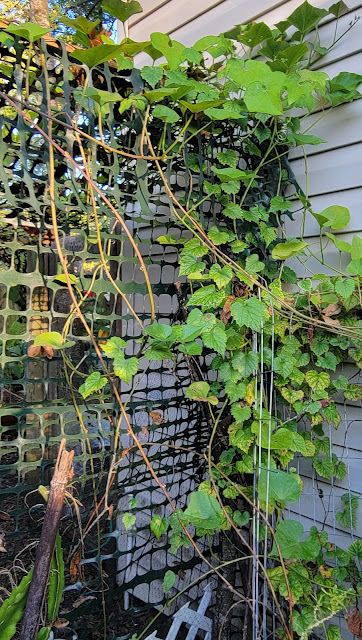











An irrigation kit is a game-changer for anyone who wants to save time and water while still keeping their plants healthy. Thanks for highlighting its benefits!
ReplyDeleteSantander Loans UK: Simplifying Your Borrowing Experience. Use Our Loan Calculator to Find the Best Personal Loans UK and Monitor Your Application Status Online. stantander login
ReplyDelete